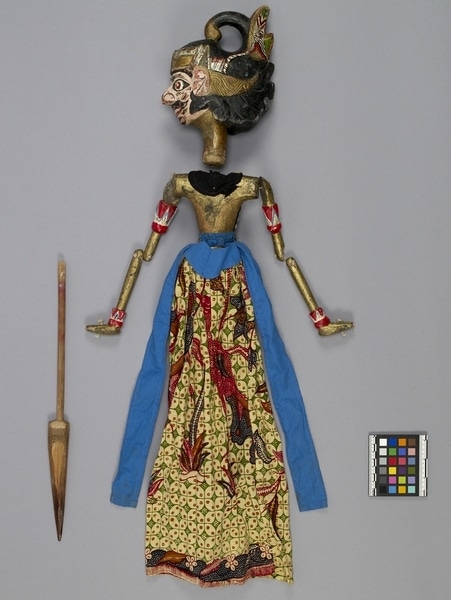Rod Puppet Item Number: Ib301 a-c from the MOA: University of British Columbia


Description
Three-dimensional male humanoid puppet: large head (part b) fits into body with skirt (part a), and a control rod (part c) with a long shaft passes through the body and fits into the neck of the figure's head. The body has jointed arms (long controlling rod missing from each). Figure has a pink face with a topong mahkota, surmounted by a jamang, badong, and sumping with points from a winged ridge. Large eyes with red irises; large nose, slightly blunt; black moustache and sideburns, gelung supit urang. Mouth open with prominent teeth. Body, moveable arms with bracelets at wrists and upper arms, black vest covering torso, leaving shoulders exposed, and black apron at waist with blue waistband. The vest, apron and waistband are decorated with beading and sequins. Hands at right angles to wrists. Skirt with geometric pattern in green and beige with large birds, flowers, and leaves in dark blue, red, yellow, and brown. Two long blue strips of fabric extend down from waist at either side.
History Of Use
Javanese puppetry as an art form probably developed by the 11th century. The three-dimensional wooden wayang golek puppets of western Java, which are to be distinguished from the earlier and more sacred wayang kulit shadow plays puppets or other forms, appeared during the 16th century. Originally the plays depicted Javanese mythology, but after the Indian conquest of Java the Hindu epics, Ramayana and Mahabharata, were incorporated into the cycles, which comprise about 200 plays. An individual or group hires a dalang (puppet-master) to celebrate important occasions. The performances often last all night and are generally presented in three acts, with vocal and instrumental accompaniment. The individual plays vary widely in detail but usually involve conflict between good and evil. They serve a moral and religious purpose, and more recently, one of political commentary. Each puppet's character is represented by its appearance and placement onstage; protagonists with strong elements of good are placed to the right, antagonists of violent or evil nature to the left. The puppet of Gandamana appears in the Mahabharata cycle of plays which is primarily concerned with the conflict between the Pandawa and Kurawa brothers who symbolically -and actively- portray the sides of good and evil (respectively). Gandamana was an advisor of the Kurawas, as demonstrated by his many evil features.
Cultural Context
Theatrical performance.
Iconographic Meaning
Pink face represents passion or more extreme emotion; large red eyes and protruding teeth associated with demons or evil beings. Gold skin considered a trait of a calm person. Clothing and elaborate headdress with jamang and sumping indicative of nobility or deities. Puppet's character deliberately ambiguous; he is neither particularly good nor evil, as he has features of both. Possibly Gandamana, who appears in the Mahabharata cycle as a patih or political advisor.
Item History
- Made in Java, Indonesia
- Owned by Tradewind Antiques before March 15, 1983
- Received from Museum of Anthropology Shop Volunteers (Funding source) and Tradewind Antiques (Seller) on March 15, 1983
What
Who
- Culture
- Sundanese
- Previous Owner
- Tradewind Antiques
- Received from
- Museum of Anthropology Shop Volunteers (Funding source) and Tradewind Antiques (Seller)
Where
- Holding Institution
- MOA: University of British Columbia
- Made in
- Java, Indonesia
When
- Ownership Date
- before March 15, 1983
- Acquisition Date
- on March 15, 1983
Other
- Condition
- fair
- Accession Number
- 0886/0035 a-c